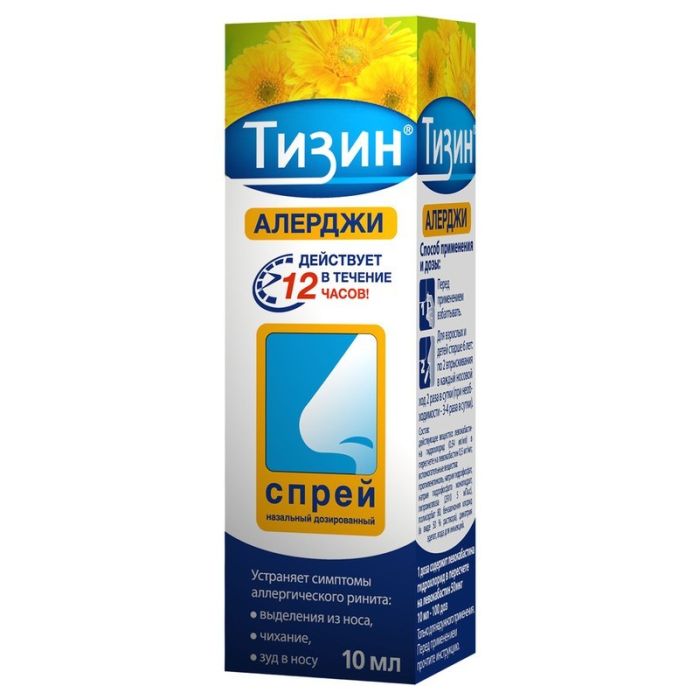Tizin Alerji ref. called dosage. 50 mcg / dose, vial 10 ml (100 doses)
Category
Allergy
Scope of the drug
General
Release form
Spray
Manufacturer country
Belgium
Package quantity, pcs
one
Release form, composition and packaging
Nasal spray dosed 50 mcg / dose, in the form of a homogeneous suspension of white color.
1 ml
levocabastine hydrochloride 0.54 mg,
- which corresponds to the content of levocabastine 0.5 mg
propylene glycol - 48.26 Ојl, sodium hydrogen phosphate - 8.66 mg, sodium hydrogen phosphate monohydrate - 5.38 mg, hypromellose (2910 5 mPa.s) - 2.5 mg, polysorbate 80 - 1 mg, benzalkonium chloride - 0.15 mg (in the form of a 50% solution - 0.03 ml ), disodium edetate - 0.15 mg, water for injection - up to 1 ml.
10 ml (100 doses) - bottles made of high density polyethylene (1) with a spray and a protective cap made of low density polyethylene - cardboard packs.
pharmachologic effect
Levocabastine is a long-acting selective histamine H1 receptor blocker.
After intranasal use, TizinAlergy eliminates the symptoms of allergic rhinitis: nasal discharge, sneezing, itching in the nasal cavity.
The local effect occurs in 5 minutes.
The action lasts until 12 noon.
Pharmacokinetics
Absorption and distribution
With each intranasal administration at the rate of 50 Ојg / dose, approximately 30-40 Ојg of levocabastine is absorbed.
Cmax of levocabastine in blood plasma is reached approximately 3 hours after nasal administration.
Levocabastine binds to blood plasma proteins by approximately 55%.
Metabolism and excretion
The main metabolite of levocabastine, acylglucuronide, is formed by glucuronidation, which is the main metabolic pathway.
T1 / 2 of levocabastine is about 35-40 hours. Levocabastine is excreted mainly in the urine unchanged (about 70% of the absorbed amount).
Indications for use
- symptomatic therapy of seasonal and perennial allergic rhinitis.
Contraindications for use
- children under 6 years old
- hypersensitivity to drug components.
The drug should be prescribed with caution in patients with impaired renal function and in elderly patients.
Dosage regimen
Intranasally administered to adults and children over 6 years of age, 2 doses (100 Ојg) into each nasal passage 2 times / day.
The use of the drug should be continued until the symptoms are eliminated.
For more severe symptoms, the drug can be used 3-4 times / day.
The patient should be warned about the need to clear the nasal passages before using the spray and inhale through the nose during administration.
Before the first use, remove the protective cap and press the spray nozzle several times until a cloud of fog" appears.
The bottle is ready for further use.
Inhale the drug through the nose.
Shake the bottle before each use.
Overdose
There have been no reports of levocabastine overdose.
Symptoms: in case of accidental ingestion, a decrease in blood pressure, tachycardia, sedation is possible.
Treatment: in case of oral administration, the patient should drink a large amount of liquid to accelerate the excretion of levocabastine by the kidneys.
Side effect
Determination of the frequency of adverse reactions: very often (> 1/10), often (> 1/100, < 1/10), infrequently (> 1/1000, < 1/100), rarely (> 1/10 000, < 1 / 1000), very rare (< 1/10 000, including individual messages), frequency unknown (incidence cannot be estimated from the available data).
Adverse events observed in patients during clinical trials
From the digestive system: often - nausea.
Infectious and parasitic diseases: often - sinusitis.
From the nervous system: very often - headache
often - drowsiness, dizziness.
From the respiratory system: often - pain in the pharynx and larynx, epistaxis
infrequently - shortness of breath, nasal congestion
rarely - swelling of the nasal mucosa
frequency unknown - bronchospasm, cough.
On the part of the cardiovascular system: infrequently - a feeling of palpitations
Name ENG
TYZINE ALERGY
Clinical and pharmacological group
Antiallergic drug - histamine H1 receptor blocker
ATX code
Levocabastine
Dosage
50mcg / dose x 10ml
Structure
1 ml: levocabastine hydrochloride 540 mcg,
the content of levocabastine 500 mcg.
Excipients: propylene glycol - 48.26 Ојl, sodium hydrogen phosphate - 8.66 mg, sodium hydrogen phosphate monohydrate - 5.38 mg, hypromellose (2910 5 mPa.s) - 2.5 mg, polysorbate 80 - 1 mg, benzalkonium chloride - 150 Ојg (in the form of a 50% solution - 30 Ојl), disodium edetate - 150 Ојg, water for injection - up to 1 ml.
Indications
Allergic rhinitis, hay fever.
Storage conditions and periods
At a temperature not higher than 25 degrees.
Expiration date: 2 years
INN / Active ingredient
Levocabastine
Contraindications
children under 6 years old
hypersensitivity to the components of the drug Tizin Alerji.
The drug should be prescribed with caution in patients with impaired renal function and in elderly patients.
Specifications
Category
Allergy
Scope of the drug
General
Release form
Spray
Manufacturer country
Belgium
Package quantity, pcs
one
Scope of application
Allergology
Minimum age from
6 years
Way of introduction
Intranasally
Vacation conditions
Without recipe
Volume, ml.
10 ml
Brand name
Tizine
The amount of the dosage form in the primary package
10 ml
Primary packaging type
Bottle
Type of consumer packaging
Pack of cardboard
Anatomical and therapeutic characteristics
R01AC02 Levocabastine
Dosage form
Dosed nasal spray
Expiration date in days
730
The target audience
Children
Package weight, g
thirty
Mode of application
:
Intranasally administered to adults and children over 6 years of age, 2 doses (100 Ојg) into each nasal passage 2 times / day.
The use of the drug should be continued until the symptoms are eliminated.
With more pronounced symptoms, the drug Tizin Alerji can be used 3-4 times / day.
The patient should be warned about the need to clear the nasal cavity before using the spray and inhale through the nose during administration.
Pharmaco-therapeutic group
:
Antiallergic agent - H1-histamine receptor blocker
Information on technical characteristics, delivery set, country of manufacture "

